Apple 27-inch LED Cinema Display Review
by Anand Lal Shimpi on September 28, 2010 12:15 AM EST- Posted in
- Displays
- Mac
- Apple
- Cinema Display
Brightness and Contrast
For brightness, black level, and contrast points, we use the same colorimeter setup described earlier. Specifically, we use an Xrite i1D2 with ColorEyes Display Pro, and take measurements at maximum and minimum brightness of white and black targets. Dynamic contrast is turned off. We also let the panels settle in for a half hour at the respective settings before taking any measurements.
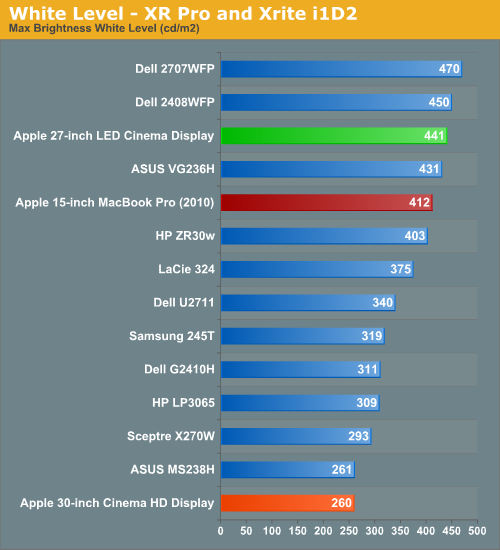
The new 27-inch LED Cinema Display is bright. It's within 10% of the 2707WFP and brighter than Dell's CCFL backlit U2711, which has a similar panel to what Apple uses in the 27-inch LED Cinema Display. If you're a fan of very bright displays, the 27-inch won't disappoint. I tossed in my 30-inch Cinema HD Display results as a reference point but keep in mind this is a very old unit (originally purchased in 2004) so it's not going to perform quite as good as it did while new.
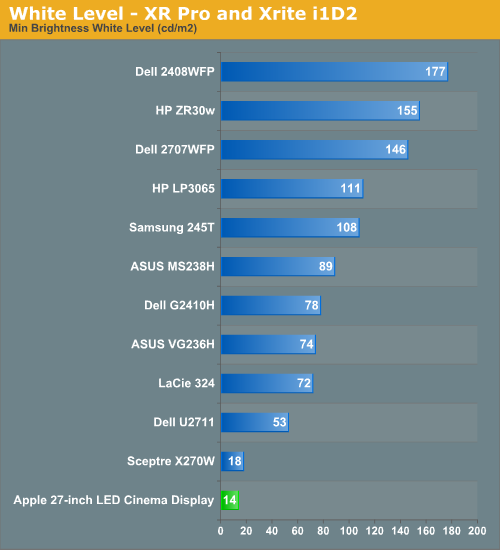
Drop brightness all the way and the 27-inch LED Cinema Display gets dim. There's a good amount of dynamic brightness range on this display, it's very flexible.
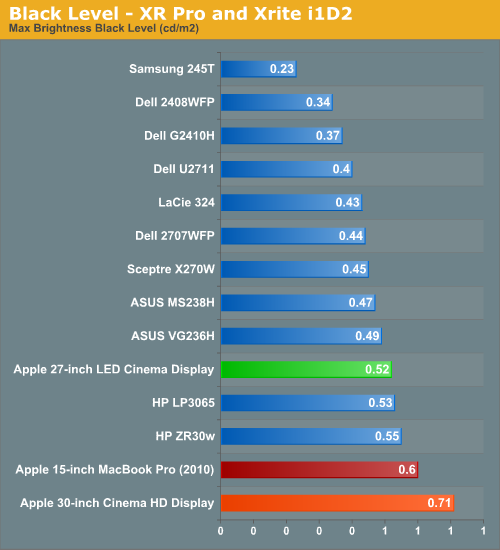
Absolute black levels are simply ok, not stellar for a high end display but not horrible either. It's clear Apple optimized for maximum brightness rather than deep blacks in order to compensate for the glossy front cover.
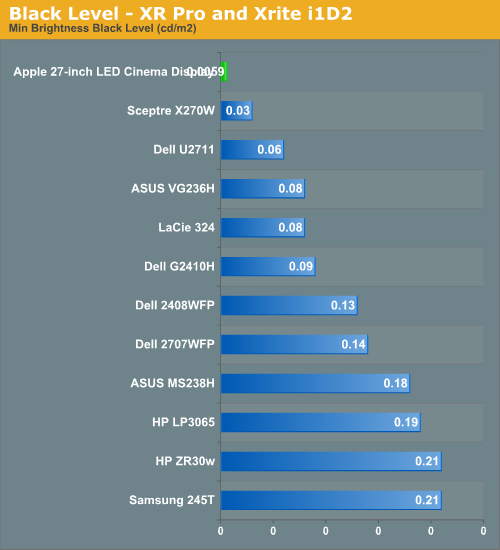
At the lowest measurable brightness setting the black levels are very low. You can actually get the display dark enough for my eyeOne D2 to register 0 nits. I had to bump brightness up a bit just to get the black level to register.
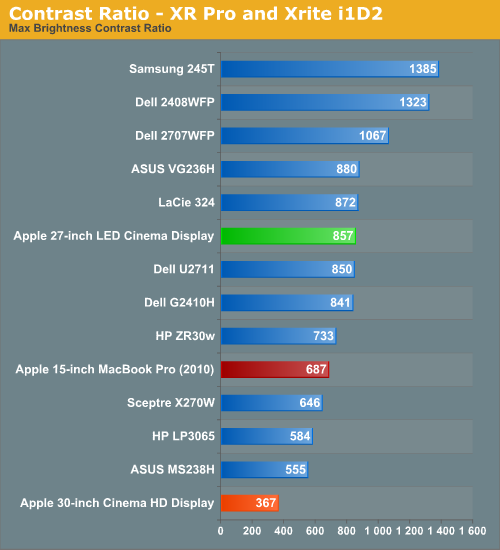
This isn't terrible but I would've liked to see something above 1000:1. Again it's sort of middle of the road for a high end display. Note that even at 200 nits the contrast ratio is 837:1, so unless you significantly reduce brightness you won't see a huge difference in contrast ratio.
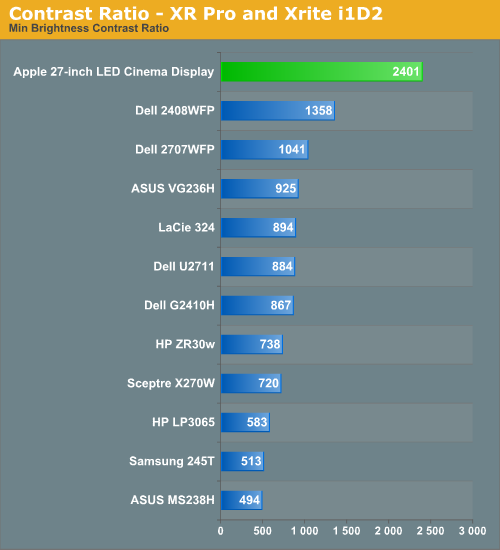
Thanks to very low black levels at the lowest brightness settings the contrast ratio skyrockets. As I mentioned before, at 200 nits the contrast ratio is still down at 837:1 so the numbers above aren't very real world unless you like using very dim displays. You can also count on the 27-inch display being quite usable at lower brightness settings as a result.










93 Comments
View All Comments
Razorjackman - Tuesday, September 28, 2010 - link
Why are all the displays from 24" and below relatively inexpensive, while the +27" seem to be disproportionately expensive?I'm still using a HannsG 28" from 2 years ago for $400.00. I expected to get larger or denser for less by now.
Does Moores Law apply to monitors?
B3an - Tuesday, September 28, 2010 - link
Because theres loads of cheap crappy TN panels in displays 24" and under, which i'd never even consider buying. Most old cheap CRT monitors would have better colours.When you move to 27" and especially 30" you start getting some quality IPS panels.
You dont just get a larger display with more pixels, you get a vastly better image too.
B3an - Tuesday, September 28, 2010 - link
... You also get better viewing angles as well.Alexstarfire - Tuesday, September 28, 2010 - link
True, but they were saying even the IPS panels for the 24" were $539 and up. Says so on the first page. A near doubling in price for an extra 3 inches isn't very compelling. Though, I don't know if the two 27" monitors they talk about are the cheapest for 27" monitors.hughlle - Tuesday, September 28, 2010 - link
Partly to do with who they are aimed at i guess. A lot of the folk opting for these high end 30" displays as opposed to just whacking an LCD tv on their desk, are using it for high end audio, graphic design etc, professional use you might say, so can be expected to spend the premium.TegiriNenashi - Tuesday, September 28, 2010 - link
I'd suggest there is a category between high end 30" and mainstream 24". There is something wrong with the market when 24" TN is <$250 and 30" IPS is >$1000 and there is nothing in-between.juncture - Tuesday, December 14, 2010 - link
These people also forgot to mention the HUGE difference being the resolution.... Try to find a 24" that has the same resolution as the $1000+ 27"-30". How was this not mentioned in this argument?plonk420 - Tuesday, September 28, 2010 - link
seconded .. it's either crap dirt cheap TNs for me ... or IPS (but preferrably oLED). i hope i never spend more than $140 on a TN again...(posting from a dying CRT ... with TN+Dell *VA as secondary)
plonk420 - Tuesday, September 28, 2010 - link
seconded @B3anTargon - Tuesday, September 28, 2010 - link
It has to do with yields and the production costs. It is far easier to make a PERFECT four inch display than an eight inch display, just because there is a smaller chance of dead or stuck pixels. As the size of the screen goes up, it just becomes that much harder to make a display without any problems.As time has gone on, with the older technologies, it has gotten easier to make larger panels that don't have problems, but now we are seeing newer technologies that raise the difficulty again.
When you got that 28 inch display, was that a 1080p or 1080i, or 720p? These days, the LED technologies are where a lot of the focus is. Then you have the move from 60Hz to 120Hz to 240Hz. 3D is also creeping in as something that will push costs up.
Two years ago, the cost of a 23 inch panel was MUCH higher than it is today, and you are seeing displays that could not do 1080p going away. So, now that 1080p is the norm for flat panel displays, the question is when better displays will become the norm on the desktop.
We also have a problem with what integrated video can handle. The Radeon 3300 integrated video for example will handle 1280x1024 decently, but starts to have a bit of a problem at 1920x1080 when it comes to basic games and such. So, before the mainstream consumer can make decent use of higher resolution displays, the base level for GPUs needs to go up by a bit more to make the experience properly "smooth".
Remember, prices come down when the manufacturers can expect high enough sales volumes to allow the drop in price to still provide a good profit. So, how many 1920x1200 displays would sell at $300 compared to 1920x1080 displays selling at $210? How about going up from there, would the general public pay for a higher quality display if their computer couldn't push the pixels well enough at the higher resolutions? Even on the gamer front, would you be willing to pay $400 for a 23 inch display with a higher resolution since the higher resolution means lower framerates?